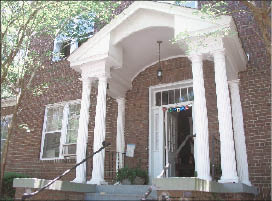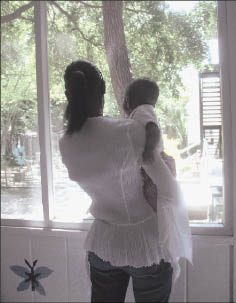 |
|
For sale no more: The Crittenton home has been welcoming girls since 1932. |
 |
|
Looking to the future: A young mother and her baby at the Florence Crittenton home in Charleston. Photo: Florence Crittenton Programs of S.C. |
 |
|
Belton: The board “didn’t know how bad it was.” |
Charleston, S.C. – Lupe Hittle-Durante walked into the stately brick home of the Florence Crittenton program here two years ago with a sensitive mission: Determine if the century-old agency for pregnant girls could be saved, or was doomed to go out of business.
The Florence Crittenton Programs of South Carolina had been pummeled to near-death by factors that are familiar to many youth programs: A cut in government funds, the loss of a key foundation grant, an overworked staff, executive director turnover and a paucity of local backers with big money.
Lurking behind all that was a fundamental problem, the visiting consultant concluded: the board of directors.
Too many of its members didn’t attend meetings. Those who did exercised little oversight. The ones who tried to help were worn down by the troubles and at a loss about what to do. The board needed to step up, the consultant said, or the agency would go under.
Hittle-Durante’s report was striking for its bluntness about a dilemma that is not uncommon among nonprofits but is rarely confronted: “The board’s role had been one of taking a back seat,” she says. “I didn’t find this agency to be that far out of the norm. …
“Boards are like this at a lot of small agencies. They believe in the mission, but they’re lost as to what their role is. They’re not willing or able to put forth the effort” to save the nonprofit when it struggles.
The financial, leadership and board struggles at the Crittenton home mirror those at many a community-based organization. Rejuvenating the board of directors has been a key part of the agency’s retreat from near-bankruptcy. That turnaround-in-progress also exemplifies how a national organization can help its affiliates assess and correct their problems, rather than just sending money.
Birth and growth
The Crittenton program here began because of a suicide – that of a young, unmarried pregnant woman in 1897. According to the agency’s historical account, a group of local women responded by opening their own homes to pregnant teens and young mothers, calling themselves the Christ Love Mission.
The girls usually signed over their babies for adoption and went home. Within a few years, the mission became part of the nascent Florence Crittenton network, which had started in New York to, in the words of the National Crittenton Foundation, rescue “lost and fallen women and wayward girls.” The Crittenton movement grew into a loose affiliation of programs around the country.
Today, the Charleston program lives in its childhood home: a two-story house that opened in 1932, standing out among smaller homes on a quiet road north of the city’s historic downtown. The home is neat and clean, but it needs help: In the executive director’s office, a thick orange power cord snakes from an air conditioner, past a dead electrical outlet, out the door and down the hall. Boxy window air conditioners throughout the home struggle against Charleston’s humidity, aided by an assortment of ceiling and floor fans. The carpets are stained and worn; the walls beg for paint.
Yet the atmosphere is cheerful. The two classrooms sport flat-screen computers, the kitchen offers a ready supply of doughnuts and other snacks, and the girls’ rooms feature personal touches, like stuffed yellow Tweety Birds on a bed. The girls follow a daily schedule of school work, life skills and parenting training, health care, counseling and chores.
The 17 girls here last month (ages 13 to 21) epitomize the changes that fueled the program’s growth, then its near-demise. “It’s not the agency it was 100 years ago,” says former board member Sam Hoerter.
The original program model was white women helping white girls who made a mistake. Today, almost every resident is black.
Many of the girls are referred to the program by government agencies and courts, and most arrive with significant issues beyond pregnancy: physical and sexual abuse, substance abuse, arrests, time in foster care and truancy from school. Their troubled histories are typical of those at Crittenton agencies around the country, says Jeannette Pai-Espinosa, president of the national foundation.
Also typical: They almost always keep their babies. Only one of the 65 girls who passed through the home last year put her baby up for adoption, says executive director Lisa Belton. At Crittentons nationwide, the adoption rate is about 2 percent, says Pai-Espinosa.
After giving birth, the girls in Charleston go home, or to living arrangements such as foster care, relatives’ homes, or apartments in the agency’s transitional living program.
The more significant needs of the girls are one reason the program has evolved from volunteer-run to professionally staffed; from Christian-based to secular; from local to taking in clients statewide; and from living off donations to relying on government funds.
With those changes, the job of running the home grew more complicated.
Trouble afoot
Some members of the board saw the trouble coming. A long-range plan developed by a board committee in 2000 found the agency to be “severely underfunded” and warned that its reliance on Medicaid for one-third of its $1 million budget was dangerous, because that funding was “not reliable.” Survival, the plan said, “depends upon our ability to raise a significant new stream of reliable, non-government funding.”
That never happened. Finding new funding sources was difficult, says Hoerter (who chaired the long-range plan committee), because the agency’s mission “is not exciting and popular in today’s world.” One major fundraising event took so much staff time and money that the agency decided never to do it again.
Raising money seemed anathema to everyone. The board was composed largely of people from social services and local businesses who did not have connections to significant philanthropic resources. As with many direct-service nonprofits, the executive directors tended to come from social work, not management.
“Nobody ever wanted to be the executive director,” says Sandra Fowler, a long-time volunteer and staffer who once served as executive director. “Sitting around and trying to raise money – it was awful.”
As Administrative Coordinator David Hoey saw when he joined several years ago, “This organization didn’t pursue many grants.”
All of that made the agency vulnerable when the long-range plan’s dire prediction came true. Around 2005, the agency learned that its Medicaid funding would drop from about $350,000 to $65,000. The reason: New rules limited the program to billing for only 16 hours of service a year for each girl – even though each girl typically lives there for months.
Some board members developed another long-range plan, but solutions remained elusive. Then, oddly, the board’s involvement faded.
Scrambling to survive
Most of the board had been “pretty passive” anyway, says Fowler. Then as the Medicaid crisis hit, Fowler was succeeded as executive director by a veteran social worker at the home, Andrea Thomas – who, some board members say, was dedicated but ran things with little input from them.
“Board meetings became an hour where you went in and listened to what she had been doing for that month,” says former employee and former board member Jan Van Norte. For several years, “our board had not been particularly involved” with the agency.
Thomas declined to comment except to say “the dynamic was not at all” like that.
Some board members preferred light involvement. To a growing degree, service on the board was a good deed that carried little responsibility; several members rarely attended meetings.
The mid-2000s were a mad scramble of living off emergency infusions, including a $400,000 line of credit with the local Tidelands Bank and a $200,000 congressional earmark that Fowler secured through a friend, U.S. Rep. James Clyburn (D-S.C.). One of Thomas’ calls for short-term help sowed the seeds for a significant intervention: She asked Pai-Espinosa at the Crittenton Foundation for a grant.
The Portland-based foundation supports its affiliates through advice, resources and advocacy, but rarely through direct funding. However, a Florence Crittenton agency had gone out of business in 2006, and Pai-Espinosa says her board members “felt that had they been notified earlier” of the problem, “they might have been able to help.”
The foundation provided the Charleston agency with $75,000 in 2007 to help it survive until it found a new financial cornerstone.
It did: a Medicaid funding stream, Psycho-Social Rehabilitation Services. The state approved the home’s application. “We had a plan” for survival, says Clinical Director Connie Hodo, recalling the we’re-gonna-make-it spirit among the staff.
But the home couldn’t find the required matching funds from agencies that referred girls there. The Medicaid funding was lost.
The end seemed near. Staffing was cut. Morale plummeted. Thomas had been growing ill and coming to the office less. “The job just got too stressful for her,” says board secretary Carol Czarnik.
Near the end of 2007, Thomas resigned. The task of saving the state’s only residential program for pregnant girls fell to its board.
Radical changes
The core of active board members found the search for an executive director frustrating. “We couldn’t get anybody” to consider the job, says Daniel Parker, then the board president. “We didn’t know if it [the agency] was going to be around in six months.”
Through Fowler the board found Greg Liotta, a former director of diversity initiatives at the College of Charleston, who was then working as a consultant and yoga instructor. Liotta says he told the board that he – a childless white male New York native with no experience running a nonprofit – “was not the right person for the job” of running a nonprofit for pregnant black girls in the South.
Board members were impressed by Liotta’s frankness, ideas and energy. He had financial experience. And they were desperate. They persuaded him to give it a try.
“They made it very clear to me that … I was taking over a sinking ship that they hoped I could save,” Liotta says.
Liotta took charge in February 2008 and drafted Lisa Belton as his assistant. She had been head of pregnancy prevention at Communities in Schools of the Charleston Area.
Liotta and Belton were stunned to find the home’s financial condition to be worse than the board realized. Before, Belton says, “they weren’t even getting regular financial reports. So they didn’t know how bad it was.”
Say Liotta: “I discovered a logistical mess best characterized by ‘clutter’: years and years worth of chaotic record-keeping, mismanaged fiscal books and a disheveled physical structure. … There was no centralized system for processing anything.” The halls, the back porch and even the small chapel next to the house were littered with donations, supplies and debris.
Belton says that when she and Liotta told the board how bad things were, “they were numb.”
Liotta took the dire conditions as license to make “radical changes,” from clearing out the mess and renovating the chapel and garden, to revamping staff positions and responsibilities.
The place was buzzing with change, some of which left workers “confused and scared,” Belton says. They saw their boss’s dedication: He sometimes slept at the office, and he and Belton skipped some paychecks. But his no-nonsense New York manner came off to some as hot-tempered intimidation.
Some staffers rolled with it. Some quit. Some complained to board members.
Some board members saw Liotta as abrasive and determined to remake the agency his way regardless of what anyone else thought. To Liotta, the board had abandoned him in what Hittle-Durante calls the main responsibility of a board: helping to ensure “financial stability.”
Not raising money
A few board members, Liotta says, never showed up or even replied to his messages. “They simply quit without resigning,” he says.
Parker, the former board president and a managing director at the investment firm Morgan Keegan, shared the frustration: With a few exceptions, he says, “no one was passionate enough about the organization to roll up their sleeves and do what needed to be done,” like raise money or find people who could.
Some board members said that calling people to raise money “is not my thing,” recalls Czarnik, the board secretary. “I’d say, ‘it’s not my thing either, but if you want to keep the home going, you’ve got to.’ …
“There are some who just want to sit on the board for recognition.”
For those who tried, the challenge was exacerbated by the home’s mission and clientele. It had always been seen as a hush-hush kind of place where, as Belton says, “a girl goes when she’s in trouble and puts the baby up for adoption.”
Over the decades, the clients had grown more alien to large parts of the community. The city’s African-American population is about 29 percent, according to the latest federal census figures. As in many cities, the races remain largely segregated. The city’s heavy hitters are not those whose daughters go to Crittenton.
“If you had 15 white girls over there who were pregnant, you’d have money flowing like you wouldn’t believe,” Parker says. “When we appealed to the city, the churches, you could see the undertone: ‘Oh, those pregnant black girls.’ ”
For board members who tried to overcome that, the worsening financial picture sapped their optimism.
In 2008, the Duke Endowment halted a pending three-year, $195,000 grant “to establish a fund-development program” (including a development director), citing the change in executive directors and the need for the agency to stabilize. Meanwhile, Belton says, as few as seven girls were living at the home which can house 20.
Some board members thought the agency was finished. Under those conditions, Parker says, “the last thing I want to do is ask someone to give $5,000 and we shut down 30 days later.”
That infuriated Liotta. “I flat-out asked him if he had faith in the viability of the agency,” Liotta says, “and he flat-out said, ‘No, not at this time.’ ”
In the midst of all of this, Hittle-Durante had arrived.
Diagnosis
Early in his tenure, Liotta had written to the Crittenton Foundation asking for more help: $100,000. The answer was no.
But “we didn’t want them to close,” says Pai-Espinosa at the foundation. The foundation offered $20,000, to be matched by the board. The board raised the money – one of several occasions in which current board President Ruth Cupp says the board came through.
Before sending the money, the foundation deployed Hittle-Durante to figure out “what was going on down there,” Pai-Espinosa says. “If they didn’t have a chance of staying open, we have to be responsible” about sending more money.
Hittle-Durante – a consultant who ran a Crittenton agency in Sioux City, Iowa, and oversaw Crittenton programs when they were part of the Child Welfare League of America – pored over agency documents and spent two days in Charleston talking with staff and board members. She did not reach most of the board, but says, “It wasn’t for lack of trying.”
The agency’s federal tax returns for the fiscal year ending June 30, 2008, show how things stood: $1 million in expenses, $703,000 in revenue.
Pai-Espinosa also came down to meet with the board and staff, and talked often with Liotta by phone. She walked the staff and board through several options, including merging with another agency, selling the house (which was put on the market for a while) and shutting down.
By the fall of 2008, Hittle-Durante submitted a report that described the board members as appearing “somewhat passive and reluctant to face the unpleasant situation. They seem overwhelmed and to be looking at external sources, other than themselves, as the answer to their problem.”
There was no consensus on “the direction the board would want to take regarding the future” of the agency, and the members “seemed to be looking for guidance and help.”
Hittle-Durante’s recommendations focused almost entirely on the board, which she said had to:
• “Allocate time and resources to reviewing and evaluating [its] own role and responsibilities.”
• “Engage in a deliberate and comprehensive planning process.”
• “Develop short-term and long-term strategies with achievable outcomes and a detailed action plan to guide [its] work.”
Also that fall, the board fired Liotta.
Climbing back
Belton was “devastated” by Liotta’s dismissal, one worker says, but she agreed to take over the executive director’s duties. She got neither a raise nor a new title.
“We didn’t see her as a long-term executive director,” Parker says. She took over because “she was the only one left.”
One of her first moves was to persuade the board to publicize the agency’s plight. “We had been afraid of sending out a signal to the community that we were in trouble,” says Van Norte, the former staffer and board member. Board members feared that people wouldn’t contribute to a dying outfit and that agencies would stop referring girls to the program.
Belton’s response: “What do you have to lose?”
Soon Belton was doing newspaper, radio and TV interviews. (The Charleston City Paper headline: “Saving Florence Crittenton: She may be old and dowdy, but she is still needed.”) The appeals brought in $206,000 from individuals, churches and other organizations, Belton says.
The agency also liquidated its endowment (about $44,000), and began more aggressively pursuing grants and donations. Recent funders include Trident United Way, the Wal-Mart Foundation, the Comcast Foundation, community groups, businesses and churches.
To cut costs, Belton and a board member persuaded the agency’s creditors to forgive about $17,000 of its $60,000 in credit card debt. The pitch, says Belton: “If we shut down, you’re not getting any of your money.”
To fill staffing gaps – the full-time staff shrank from 24 in 2000 to 13 now – the agency has used volunteers for such tasks as answering phones and making repairs.
The most fundamental change has been in the board of directors.
Belton and Pai-Espinosa believe the agency’s near-death experience put a new charge into some board members. A few who had not shown up for a long time were sent letters saying they were no longer on the board, Belton says.
“We needed some new blood.”
Last year, the board grew to 18 members (having been as low as 11). “We wanted people with financial backgrounds,” Belton says. The recruits include accountants and bankers, such as Brian Michel, who arranged the line of credit years ago. Michel says he scrutinizes the agency’s financial statements and presses it to keep procedures tight.
Another key, says Van Norte: “We gave the board members more precise tasks,” like working on committees for such issues as long-range planning, programming, fundraising, and buildings and grounds.
Now almost all members attend the board meetings, Belton says. She calls the board “committed and energetic,” although, “we don’t really have a fundraising expert on the board. … They’re learning.”
While “everybody still has three jobs,” in the words of Hodo, the clinical director, things are stable enough for employees to get moderate raises for the first time in years. Even Belton got a raise this spring: to the executive director’s salary, matching the title she was given a year earlier.
Belton projects that the agency will take in and spend a little more than $900,000 this fiscal year. Challenges remain: The home has debts to pay off, and the cash-strapped state recently slashed the agency’s Social Security Block Grant funding (about $280,000 annually),
At the national foundation, Pai-Espinosa has dispatched Hittle-Durante to assess another struggling Crittenton agency. The foundation president thinks providing such an assessment, along with expert advice, resources (like media kits) and funding, “is a good model.”
Liotta, whose SOS ignited that help, thinks things turned out best for everyone. Without the “ordeal,” he says, he would not have spent a year at an ashram and “would not be where I am today” – working at a drug abuse treatment program in Antigua.
Contact: National Crittenton Foundation (503) 297-2217, http://www.thenationalcrittentonfoundation.org; Florence Crittenton Programs of South Carolina (843)722-7526, http://www.florencecrittentonsc.org.






























